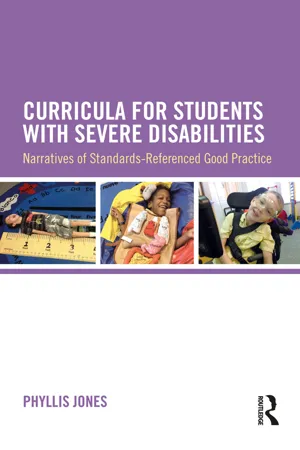
Curricula for Students with Severe Disabilities
Narratives of Standards-Referenced Good Practice
- 168 pages
- English
- ePUB (mobile friendly)
- Available on iOS & Android
Curricula for Students with Severe Disabilities
Narratives of Standards-Referenced Good Practice
About this book
Students with severe disabilities comprise 2 percent of the population of learners who are impacted by intellectual, communicative, social, emotional, physical, sensory and medical issues. Increasingly, however, teachers are required to meet the challenges of creating a pedagogical balance between an individual student's strengths, needs and preferences, and core academic curricula. The need to embrace the current initiative of curriculum state standards in the debate of curricula relevance, breadth, balance and depth for students with severe disabilities is not just timely—it contributes to the evolving debate of what constitutes an appropriate curriculum for severely disabled learners.
Curricula for Students with Severe Disabilities supports the development of greater understandings of the role that state curriculum standards play in the pedagogical decision-making for students with severe intellectual disabilities. The book first discusses the nature and needs of these students, the curriculum for this group of learners and the recent contributions of state curriculum standards, before presenting narratives of real classrooms, teachers and students who have meaningfully integrated state curriculum standards at the kindergarten, elementary and high school levels.
Frequently asked questions
- Essential is ideal for learners and professionals who enjoy exploring a wide range of subjects. Access the Essential Library with 800,000+ trusted titles and best-sellers across business, personal growth, and the humanities. Includes unlimited reading time and Standard Read Aloud voice.
- Complete: Perfect for advanced learners and researchers needing full, unrestricted access. Unlock 1.4M+ books across hundreds of subjects, including academic and specialized titles. The Complete Plan also includes advanced features like Premium Read Aloud and Research Assistant.
Please note we cannot support devices running on iOS 13 and Android 7 or earlier. Learn more about using the app.
Information
Section II
Introduction
Introduction to the Schools
Orchard Hill School Written With Robin Myers
Spring Park School Written With Edwina Oliver
- The A.C.T.I.O.N. Team
- The TRANSITION Team K–8
- The TRANSITION Team 9–12+
- The SPECTRUM Team
- The DAT Team.
Chapter 5
Fact or Fiction
The Classroom
The Adults
The Students
Table of contents
- Cover
- Title
- Copyright
- Dedication
- Contents
- Acknowledgements
- SECTION I
- SECTION II
- References
- Index